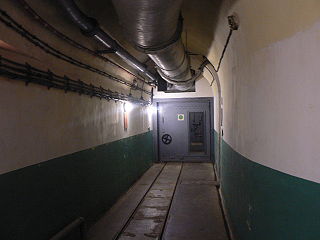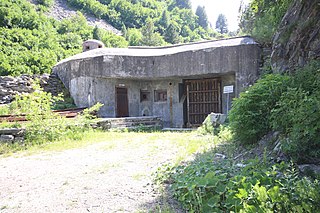
Ouvrage Hobling is a lesser work of the Maginot Line. Located in the Fortified Sector of Boulay, the ouvrage consists of two infantry blocks and two observation blocks, and is located between gros ouvrage Michelsberg and petit ouvrage Bousse, facing Germany. It has been stripped of metals and abandoned.

Ouvrage Saint-Gobain is a work of the Maginot Line's Alpine extension, the Alpine Line. The ouvrage consists of one entry block, one infantry block, one artillery block, one observation block and one combination block. Located in Modane, France, it is just across the valley of the Arc from Ouvrage Saint-Antoine and somewhat to the east of Ouvrage Sapey.

Ouvrage Le Lavoir Is a work of the Maginot Line's Alpine extension, the Alpine Line, also called the Little Maginot Line. The ouvrage consists of two entry blocks, one infantry block, three artillery blocks and one observation block 6 kilometres (3.7 mi) south of Modane, France, guarding the Col de Fréjus. The surface barracks at Le Lavoir were connected to Charmaix by an aerial tram.

Ouvrage Col du Granon is a lesser work of the Maginot Line's Alpine extension, the Alpine Line. The ouvrage consists of one entry block, one infantry block and one observation block covering the Col du Granon as part of the defenses of Briançon and Grenoble. The ouvrage lies at an altitude of 2,329 metres (7,641 ft).

Ouvrage Les Aittes is a lesser work of the Maginot Line's Alpine extension, the Alpine Line. The ouvrage consists of one entry block, three infantry blocks and one observation block, about two kilometers east of Cervières, Hautes-Alpes at an altitude of 2,029 metres (6,657 ft)..

Ouvrage Gondran is a lesser work of the Maginot Line's Alpine extension, the Alpine Line. The ouvrage consists of one entry block, one infantry block and one observation block. Gondran was commenced in June 1933, and was intended to cover the gap between Janus and Les Aittes. The site is close to two older forts, designated Gondran C and Gondran D. The Maginot fortification became known as Gondran E.

Ouvrage Restefond is a work of the Maginot Line's Alpine extension, the Alpine Line. The ouvrage consists of one artillery block and three observation blocks at the summit of the Col de la Bonette. The entry block and an artillery block were not completed, and a further block was never built. At 2,733 metres (8,967 ft), Restefond is the highest Maginot ouvrage.

Ouvrage Col de Restefond is a lesser work of the Maginot Line's Alpine extension, the Alpine Line. The ouvrage consists of three infantry blocks. It is located directly adjacent to the Col de Restefond road at an altitude of 2,680 metres (8,790 ft). Construction work was completed in 1934, but the ouvrage was not armed until 1938.

Ouvrage La Moutière is a lesser work of the Maginot Line's Alpine extension, the Alpine Line at an altitude of 2440 meters. The ouvrage consists of one entry block, one infantry block and one observation block, with an unarmed exit block. The ouvrage supported the Ouvrage Restefond on the crest of the pass, guarding its southern flank. It also covered the Col de la Barcelonnette to the north. The position was built between 1931 and 1935.

Ouvrage Col du Caire Gros is a lesser work of the Maginot Line's Alpine extension, the Alpine Line. The ouvrage consists of two entry blocks at an altitude of 2,048 metres (6,719 ft). Additional blocks were planned but not built.

Ouvrage Col du Fort is a lesser work of the Maginot Line's Alpine extension, the Alpine Line. The ouvrage consists of one infantry block and one observation block at an elevation of 1,717 metres (5,633 ft). An additional block was planned but not built.

Ouvrage Gordolon is a work of the Maginot Line's Alpine extension, the Alpine Line, also known as the Little Maginot Line. The ouvrage consists of one and two infantry blocks at an altitude of 728 metres (2,388 ft). Gordolon was built by Borie contractors at a cost of 21.4 million francs. Work started in November 1931 and was completed in April 1934.

Ouvrage Plan Caval is a lesser work of the Maginot Line's Alpine extension, the Alpine Line, also known as the Little Maginot Line. The ouvrage consists of two infantry blocks and one observation block facing Italy. The ouvrage is located on the heights of L'Authion, surrounded by older fortifications. Three additional blocks were planned to make it a gros ouvrage but were not built. Cost for the full ensemble was estimated at 23 million francs.

Ouvrage La Béole is a lesser work of the Maginot Line's Alpine extension, the Alpine Line. The ouvrage consists of one entry block and two observation blocks at an altitude of 1,548 metres (5,079 ft). The ouvrage consists of two entry blocks and one observation block facing Italy. The ouvrage was manned by 94 soldiers in 1940, under the command of Sub-Lieutenant Caillard. Additional blocks were planned but not built. The ouvrage was never provided with electricity. Three more blocks were planned but not built.

Ouvrage Monte Grosso is a work of the Maginot Line's Alpine extension, the Alpine Line, also known as the Little Maginot Line. The ouvrage consists of one entry block, four artillery blocks and two observation blocks facing Italy. It was the largest ouvrage in the Alps It is part of the fortifications surrounding Sospel, which protect the approaches to Nice from the north.

Ouvrage Champ de Tir, also known as Champ de Tir de l'Agaisen is a lesser work of the Maginot Line's Alpine extension, the Alpine Line. It is located at an altitude of 672 metres (2,205 ft), less than 1 kilometer to the northwest of Ouvrage l'Agaisen. The ouvrage consists of two entry blocks and one infantry block, sited to control the valley of the Nieya and to observe for l'Agaisen.

Ouvrage Saint-Roch is a work of the Maginot Line's Alpine extension, the Alpine Line, also known as the Little Maginot Line. Small for a gros ouvrages, the ouvrage consists of one entry block, one artillery block and two observation blocks overlooking Sospel at an altitude of 426 metres (1,398 ft). The position is located just to the southwest of Sospel, its entrance block in a narrow valley and the artillery block on the other side of the ridge overlooking Sospel. The ouvrage is laid out along a single line, with the entry block to the rear, immediately followed by the usine, with barracks farther along and Blocks 2 and 3 at intervals. The position's main armament is concentrated in Block 4, a massive blockhouse designed to protect against rockfalls from higher up the mountain.

Ouvrage Col de Garde is a lesser work of the Maginot Line's Alpine extension, the Alpine Line, also called the Little Maginot Line. The ouvrage consists of two entry blocks, one infantry block and one observation block, slightly more than 1 km south of Sainte-Agnès.

Ouvrage Roquebrune is a work of the Maginot Line's Alpine extension, the Alpine Line. The ouvrage consists of one entry block, two artillery blocks and one observation block facing Italy. The fortification is located on the heights behind Roquebrune at an elevation of 321 meters overlooking Cap Martin and the bays of Roquebrune and Menton. The ouvrage was manned by 293 men of the 58th Demi-Brigade Alpin de Forteresse (DBAF), supported by the 157th Régiment d'Artillerie de Position (RAP), under the command of Captain Gayot.

Ouvrage Croupe du Réservoir is a lesser work of the Maginot Line's Alpine extension, the Alpine Line. Located on the heights of Roquebrune at an elevation of 139 meters, the ouvrage consists of one entry block and one observation block facing Italy and covering the Grande Corniche road. The fortification was manned by 60 troops of the 58th Demi-Brigade Alpin de Forteresse (DBAF) under the command of sous-lieutenant Roman.













